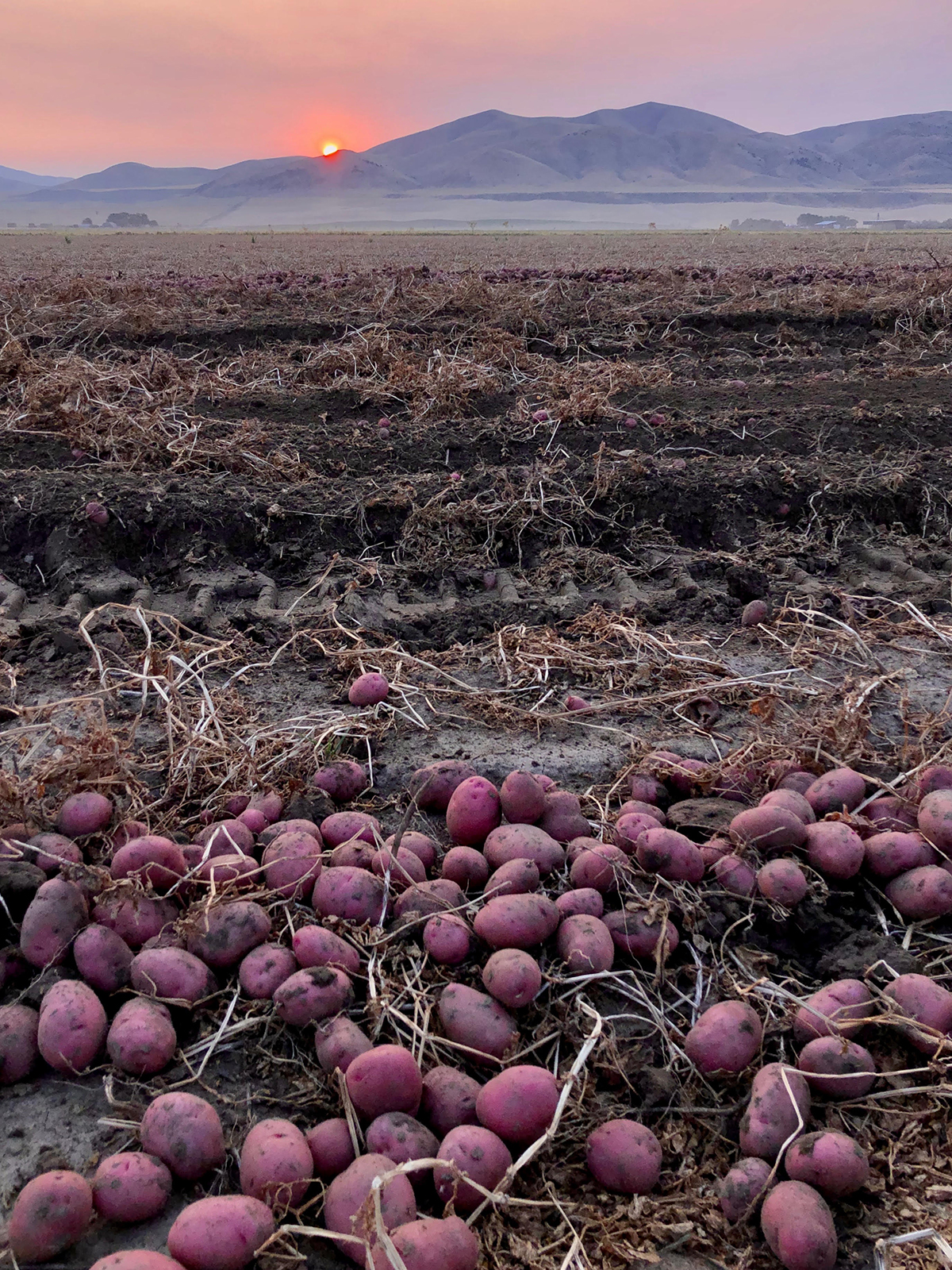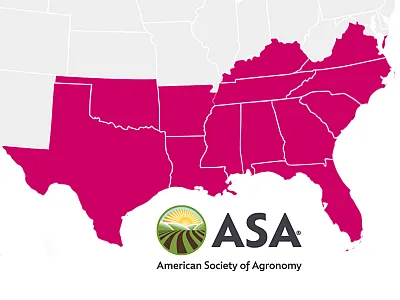Reducing greenhouse emissions in Pacific Northwest potato systems


Soil health management practices can help reduce greenhouse gas (GHG) emissions from potato cropping systems in the Pacific Northwest. Because adopting practices like reduced tillage, cover cropping, and organic applications requires time and valuable resources, selecting the right approach to meet a farmer’s goals is essential. This article elaborates on how sustainable practices can be adopted for potato production in the Pacific Northwest (PNW) region to lower GHG emissions, based on a web-based modeling tool known as COMET-Farm.
Earn 1 CEU in Sustainability by reading this article and taking the quiz.
Any gases in the atmosphere that trap heat are called greenhouse gases (GHG). The primary GHG are carbon dioxide (CO2, 79.7%), methane (CH4, 11.1%), and nitrous oxide (N2O, 6.1%). Many organizations want to lower GHG emissions throughout their production chain to meet sustainability goals or participate in the voluntary carbon marketplace. Thus, having the tools to reduce these GHG emissions can have a positive impact on the environment as well as an organization’s economics.
Agronomists, crop advisers, and producers play an important role in avoiding or mitigating GHG emissions in the agricultural sector. Adopting soil health management practices like reduced tillage, cover cropping, and compost addition have been observed to lower GHG emissions as well as increase soil health at the national or global scale (Bagnall et al., 2023; Yue et al., 2023). However, the impact of adopting soil health management practices on lowering GHG emissions in potato systems of the Pacific Northwest remains understudied. In this article, we will discuss how adopting soil health management practices in potato systems can reduce GHG emissions. This information can be used by multiple stakeholders in several ways:
Potato farmers can use the data to inform how they manage their production to decrease GHG emissions.
Agricultural service providers can use the information to support their recommendations to farmers to decrease GHG emissions.
Industry professionals can use the data to quantify progress towards sustainability goals, including calculation of scope three emissions (i.e., emissions within an organization’s supply chain).
Using models to estimate greenhouse gas changes from practice adoption
In the following section, we will discuss how we compared the impact of different soil health management practices on GHG emissions in potato systems. We generated the results using a web-based modeling tool known as COMET-Farm to quantify the effect of soil health management practices on GHG emissions in potato systems in the Pacific Northwest (PNW) region. COMET-Farm was developed through a partnership between Colorado State University and the USDA. COMET-Farm lets users simulate different management scenarios to quantify how changes in management practices, such as adoption of sustainable practices, impacts GHG emissions, including soil carbon (C) sequestration.
To determine which practices and rotations we should simulate, we contacted potato experts in the PNW region and asked them to identify a typical rotation in potato systems. Within each rotation (corn, vegetable, and alfalfa), we simulated different practice scenarios using COMET-Farm (Table 1). The effect of such scenarios on GHG emissions was tested in five locations in the PNW region (Figure 1). These locations represented a variety of soil types to help understand the impact of adopting practices irrespective of the difference in soils in the PNW region.
We chose to simulate three typical practices implementable in potato production systems: reduced tillage, cover cropping, and compost addition. Reduced till consisted of removing two tillage events for each non-potato crop in the rotation. For cover crops, we simulated planting winter wheat between all cash crops while simultaneously reducing synthetic nitrogen input by 25% in all years. For composting scenarios, we added dairy compost (C:N ratio = 15:1) gradually to make up 20% of the synthetic N for five years. We also investigated scenarios where these practices were applied in combination or stacked. All scenarios were compared with a business as usual (BAU) scenario, which did not utilize any of the practices.

This paragraph provides some necessary context on the output obtained from the COMET-Farm simulations. The results presented here show total GHG emissions for a theoretical 120-ac farm. Results are presented in terms of metric tons (tonnes) of CO2 equivalent (CO2-eq). We do this because different GHG have different global-warming potential. For example, N2O has a global-warming potential 273 times greater than CO2 (i.e., 1 ton of N2O contributes to the same amount of warming as 273 tons of CO2). Using CO2-eq, we normalize the global-warming potential of all GHGs and present the results in terms of the warming that would have occurred if the only GHG emitted was CO2. Therefore, the results from CO2-eq show the potential effect on global warming from not only CO2, but also N2O and CH4 emissions.
Rotation | Sustainable practice | |||
|---|---|---|---|---|
| Scenarioa | Year 1 | Year 2 | Year 3 | |
| Corn BAU | Potato | Field corn | Field corn | none |
| Corn RT | Potato | Field corn | Field corn | Reduced till |
| Corn CP | Potato | Field corn | Field corn | Compost |
| Corn CC | Potato | Field corn | Field corn | Cover crop |
| Corn RT + CC | Potato | Field corn | Field corn | Reduced till and cover |
| Corn RT + CC + CP | Potato | Field corn | Field corn | Reduced till, cover, and compost |
| Veg BAU | Potato | Pea/sweet corn | Carrot | none |
| Veg RT | Potato | Pea/sweet corn | Carrot | Reduced till |
| Veg CP | Potato | Pea/sweet corn | Carrot | Compost |
| Alfalfa BAU | Potato | Alfalfa | Alfalfa | none |
aBAU, business as usual (no sustainable practice); RT, reduced till; CP, compost addition; and CC, cover crop.

Rotation plays a key role in reducing emissions
In this section, we will focus on the results of COMET-Farm simulations comparing the impact of different rotations (alfalfa, corn, or vegetable) in a potato system on GHG emissions. Rotation can also be considered a soil health practice as it increases diversity in the cropping system. In this article, we are comparing the different rotations on GHG emissions. Again, these results are for a hypothetical 120-ac center-pivot potato system in the PNW.
There is potential to decrease GHG emissions in potato systems just by altering the rotating crops (Figure 2). Rotating potato with alfalfa resulted in the lowest GHG emissions followed by corn and vegetable rotations, respectively. When changing from an alfalfa rotation to a corn rotation, the GHG emission increased by 90%. When changing from an alfalfa rotation to a vegetable rotation, the GHG emission increased by 141%. In terms of real-world impact, emissions from the alfalfa rotation were equivalent to the average annual emissions of 18 cars whereas emissions from corn and vegetable rotations were equivalent to the annual emissions from 37 and 47 cars, respectively (Figure 2).
Much of these GHG emissions were in the form of N2O and were driven by nitrogen. As vegetables require greater nitrogen input, vegetable rotation resulted in larger N2O emission than corn and alfalfa. In conclusion, nitrogen heavy rotations (e.g., vegetables) can result in greater GHG emissions compared with lower nitrogen-demanding perennial rotations (e.g., alfalfa). These results highlight the importance of N fertilizer management.

Adopting soil health management practices can decrease emissions in potato–corn systems
In this section, we will discuss how adopting soil health management practices like reduced till (RT), cover crops (CC), compost (CP), and various combinations of these practices can impact GHG emissions in a potato–corn rotation. While we are only presenting results of corn–potato systems, similar results for reduced-tillage practice were observed in vegetable–potato systems as well. Business as usual (BAU) represents a scenario where no sustainable practices were adopted (Table 1). We will be sharing the decrease in GHG emissions between BAU and systems with the addition of sustainable practices.
Adoption of sustainable practices resulted in decreasing GHG emissions in potato–corn systems (Figure 3). Compared with BAU, adopting reduced till (RT) and compost (CP) resulted in very small reductions in GHG emissions of 6 and 3% for RT and CP, respectively. However, adding cover crops (CC) resulted in significant GHG reductions (34%). The results show that when adopting a single practice, cover cropping resulted in the largest and most reliable decrease in GHG emissions.
When the soil health management practices were combined, the decrease in GHG emissions increased substantially. Reduced till combined with cover cropping (RT+CC) resulted in a 42% decrease in GHG emissions. A combination of reduced till, cover crops, and compost (RT+CC+CP) resulted in the greatest decrease in GHG emissions compared with BAU (51%). In real-world terms, cover cropping alone resulted in GHG emission reductions equivalent to the annual emission from 13 cars while the combination of all three sustainable practices (RT+CC+CP) resulted in GHG emission reductions equivalent to the annual emission from 19. In conclusion, cover cropping was the singular practice that resulted in the largest GHG reduction, but when combined with other sustainable practices, it can achieve the maximum reduction in GHG emission for potato systems.
The results show that when adopting a single practice, cover cropping resulted in the largest and most reliable decrease in GHG emissions.

Co-benefits from adopting soil health management practices for potato production in the Pacific Northwest
In this article, we have explored rotation as well as soil health management practices as tools to reduce GHG emissions for potato production in the PNW region. In addition to reducing GHG emissions, adoption of soil health management practices can also have other co-benefits. One such co-benefit, as shown by COMET-Farm, is the increase in available water-holding capacity of the soil (AWHC). COMET-Farm predicts AWHC using a soil carbon and clay based model from Bagnall et al. (2022). Greater AWHC can translate to decreased crop water stress and reduced irrigation demand.
Even though small, there can be a positive impact on AWHC of the soil from the adoption of soil health management practices (Figure 4). Compost addition (CP) resulted in a 0.8% increase in AWHC, which represents the largest increase in AWHC for a single practice change. Similar to GHG emission reduction, the greatest increase in AWHC (1%) resulted when all three practices were stacked (RT+CC+CP). While a 1% increase in AWHC might seem small, it is equivalent to an increase of 241 gal water/ac. All of these changes represented improvements compared with a potato–corn system under BAU (business as usual, no soil health practice adoption) management.
The AWHC of the soil was one of the co-benefits that could be observed using the COMET-Farm results. In addition, published work on these practices also point to other co-benefits that could be observed like decreased erosion, lower fertilizer costs due to decreased input needs, and increased soil health.
Interestingly, compost had the lowest contribution to GHG emission reductions but the largest improvement in AWHC. This highlights the importance of considering potential co-benefits to the adoption of soil health management practices. If you were only looking to adopt practices to reduce GHG emissions, you may find the relatively small impact of compost on GHG emissions to be uncompelling evidence to support adopting compost as a practice. However, drawing this conclusion would miss out on the potential additional benefits of integrating compost into a system (e.g., improvements in AWHC). This highlights the complexity of sustainable crop management; there are multiple benefits and trade-offs to adopting practices, and to meet farmer goals, multiple factors need to be considered to decide whether to adopt a practice or not.

Summary
Crop rotation and soil health management practices represent promising tools to reduce greenhouse gas emissions for potato production in the PNW region. Rotating potatoes with lower nitrogen-demanding crops can lower GHG emissions with the largest reductions occurring when alfalfa is included in a potato rotation. All three of the practices we explored can be adopted to decrease GHG emissions in potato–corn rotations. However, cover crops represented the singular practice that resulted in the largest and most reliable reduction of GHG emissions. To achieve maximum GHG reductions, all three soil health management practices (reduced till + cover crop + compost) should be combined. Besides decreasing GHG emissions, practices can have co-benefits like increasing the soil's ability to store water and improving soil health. Agronomic tools like rotation and soil health management practices show potential to pave the path towards reducing GHG and improving the sustainability of potato systems in the PNW region.
Acknowledgements
This work is supported by the U.S. Department of Agriculture (USDA) Natural Resources Conservation Service (NRCS), Partnership for Climate-Smart Commodities Grant No. NR233A750004G026 to Oregon State University's Global Hemp Innovation Center, Climate-Smart Potatoes from the Pacific Northwest–Managing Soil Health for Climate-Smart Outcomes.
References
Bagnall, D. K., Morgan, C. L., Cope, M., Bean, G. M., Cappellazzi, S., Greub, K., . . . & Tracy, P. (2022). Carbon‐sensitive pedotransfer functions for plant available water. Soil Science Society of America Journal, 86(3), 612–629.
Bagnall, D. K., Rieke, E. L., Morgan, C. L., Liptzin, D. L., Cappellazzi, S. B., & Honeycutt, C. W. (2023). A minimum suite of soil health indicators for North American agriculture. Soil Security, 10, 100084.
Yue, K., Fornara, D. A., Heděnec, P., Wu, Q., Peng, Y., Peng, X., . . . & Peñuelas, J. (2023). No tillage decreases GHG emissions with no crop yield tradeoff at the global scale. Soil and Tillage Research, 228, 105643.
Self-study CEU Quiz
Earn 1 CEU in Sustainability by taking the quiz for the article. For your convenience, the quiz is printed below. The CEU can be purchased individually, or you can access as part of your Online Classroom Subscription.
Which greenhouse gas is the most abundant in the atmosphere?
a. Carbon dioxide.
b. Nitrous oxide.
c. Methane.
d. Oxygen.
Which three crops rotated with potatoes are compared in this article?
a. Alfalfa-beets-corn.
b. Alfalfa-corn-vegetables.
c. Alfalfa-fallow-corn.
d. Alfalfa-fallow-fallow.
Which crop rotation with potatoes resulted in the lowest greenhouse gas emissions?
a. Corn.
b. Vegetables.
c. Wheat.
d. Alfalfa.
Which single soil health management practice resulted in the greatest decrease in greenhouse gas emissions?
a. Reduced till.
b. Cover crops.
c. Compost.
d. Conventional till.
What practice/s could you adopt to achieve maximum reduction in greenhouse gas emissions?
a. Reduced till.
b. Cover crops.
c. Compost.
d. A combination of all three.
Which single practice resulted in the greatest improvement in available water-holding capacity AWHC of the soil?
a. Reduced tillage.
b. Cover crops.
c. Compost.
d. None of the above.
Which environmental outcome does COMET-Farm NOT estimate?
a. Runoff.
b. Nitrous oxide emissions.
c. Soil carbon sequestration.
d. Methane emissions.
Adding reduced till, cover crops, and compost to corn rotations increased available water-holding capacity (AWHC) of the soil by ____ gallons per acre.
a. 10
b. 115
c. 241
d. 279
COMET-Farm estimates for cover cropping included a 25% reduction in N fertilizer
a. True.
b. False.
10. Which of these are co-benefits of sustainable practices?
a. Improved soil health.
b. Reduced erosion.
c. Reductions in N fertilizer needs.
d. All of these are co-benefits.
Text © . The authors. CC BY-NC-ND 4.0. Except where otherwise noted, images are subject to copyright. Any reuse without express permission from the copyright owner is prohibited.









